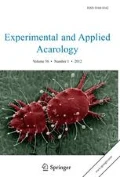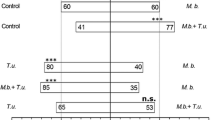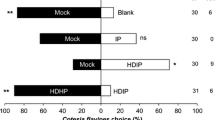Abstract
We tested the extent to which resistance of common bean (Phaseolus vulgaris) cultivars to the spider mite Tetranychus urticae parallels the extent to which these plants display indirect defenses via the induced attraction of the predatory mite Phytoseiulus persimilis. First, via field and greenhouse trials on 19 commercial bean cultivars, we selected two spider mite-resistant (Naz and Ks41128) and two susceptible (Akthar and G11867) cultivars and measured the spider mite-induced volatiles and the subsequently induced attraction of predatory mites via olfactory choice assays. The two major volatiles, 4,8,12-trimethyltrideca-1,3,7,11-tetraene (TMTT) and (Z)-3-hexenyl-acetate, were induced in the resistant but not in the susceptible cultivars. However, uninfested susceptible cultivars emitted these volatiles at levels similar to those of mite-infested resistant cultivars. Significant induction of several minor components was observed for all four cultivars except for the infested-susceptible cultivar G11867. Both, the spider mite-resistant cultivar Naz and the susceptible cultivar G11867, attracted more predatory mites when they were infested. In contrast, spider mites induced increased emission of two major and five minor volatiles in Ks41128, but predatory mites did not discriminate between infested and uninfested plants. Overall, the attraction of predatory mites appeared to correlate positively with the presence of TMTT and (Z)-3-hexenyl acetate and negatively with β-caryophyllene and α-pinene in the bean headspace. Taken together, our data suggest that resistance and attraction of natural enemies via induced volatiles are independent traits. We argue that it should be possible to cross predator-attraction promoting traits into resistant cultivars that lack sufficiently inducible indirect defenses.




Similar content being viewed by others
References
Agelopoulos NG, Chamberlain K, Pickett JA (2000) Factors affecting volatile emissions of intact potato plants, Solanum tuberosum: variability of quantities and stability of ratios. J Chem Ecol 26:497–511
Alba JM, Bleeker PM, Glas JJ, Van Wijk M, Sabelis MW, Schuurink RC, Kant MR (2012) The impact of plant volatiles on plant-arthropod interactions. In: Smagghe G, Diaz I (eds) Arthropod-plant interactions: novel insights and approaches for IPM. Springer, Heidelberg, pp 15–73
Ament K, Kant MR, Sabelis MW, Haring MA, Schuurink RC (2004) Jasmonic acid is a key regulator of spider mite-induced volatile terpenoid and methyl salicylate emission in tomato. Plant Physiol 135:2025–2037
Ament K, Van Schie CC, Bouwmeester HJ, Haring MA, Schuurink RC (2006) Induction of a leaf specific geranylgeranyl pyrophosphate synthase and emission of (E,E)-4,8,12-trimethyltrideca-1,3,7,11-tetraene in tomato are dependent on both jasmonic acid and salicylic acid signaling pathways. Planta 224:1197–1208
Arimura G, Tashiro K, Kuhara S, Nishioka T, Ozawa R, Takabayashi J (2000) Gene responses in bean leaves induced by herbivory and by herbivore-induced volatiles. Biochem Biophys Res Comm 277:305–310
Baldwin IT (1998) Jasmonate-induced responses are costly but benefit plants under attack in native populations. Proc Natl Acad Sci USA 95:8113–8118
Ballhorn DJ (2011) Constraints of simultaneous resistance to a fungal pathogen and an insect herbivore in lima bean (Phaseolus lunatus L.). J Chem Ecol 37:141–144
Ballhorn DJ, Heil M, LiebereiI R (2006) Phenotypic plasticity of cyanogenesis in lima bean Phaseolus lunatus—activity and activation of beta-glucosidase. J Chem Ecol 32:261–275
Ballhorn DJ, Kautz S, Lion U, Heil M (2008) Trade-offs between direct and indirect defences of lima bean (Phaseolus lunatus). J Chem Ecol 96:971–980
Beck JJ (2012) Addressing the complexity and diversity of agricultural plant volatiles: a call for the integration of laboratory- and field-based analyses. J Agricult Food Chem 60:1153–1157
Benrey B, Callejas A, Rios L, Oyama K, Denno RF (1998) The effects of domestication of Brassica and Phaseolus on the interaction between phytophagous insects and parasitoids. Biol Control 11:130–140
Bernstein C (1984) Prey and predator emigration responses in the acarine system Tetranychus urticae–Phytoseiulus persimilis. Oecologia 61:134–142
Boudart G, Lafitte C, Barthe JP, Frasez D, Esquerre-Tugaye MT (1998) Differential elicitation of defense responses by pectic fragments in bean seedlings. Planta 206:86–94
Brillada C, Nishihara M, Shimoda T, Garms S, Boland W, Maffei ME, Arimura G (2013) Metabolic engineering of the C16 homoterpene TMTT in Lotus japonicus through overexpression of (E,E)-geranyllinalool synthase attracts generalist and specialist predators in different manners. New Phytol 200:1200–1211
Bynum ED, Xu WW, Archer TL (2004) Diallel analysis of spider mite resistant maize inbred lines and F-1 crosses. Crop Sci 44:1535–1541
Cipollini DF (1997) Wind-induced mechanical stimulation increases pest resistance in common bean. Oecologia 111:84–90
De Boer JG, Dicke M (2006) Olfactory learning by predatory arthropods. Anim Biol 56:143–155
Degenhardt J, Hiltpold I, Kollner TG, Frey M, Gierl A, Gershenzon J, Hibbard BE, Ellersieck MR, Turlings TCJ (2009) Restoring a maize root signal that attracts insect-killing nematodes to control a major pest. Proc Natl Acad Sci USA 106:13213–13218
Dicke M, Sabelis MW (1988) How plants obtain predatory mites as bodyguards. Neth J Zool 38:148–165
Dicke M, Van Beek TA, Posthumus MA, Dom NB, Van Bokhoven H, De Groot AE (1990) Isolation and identification of volatile kairomone that affects acarine predator prey interactions Involvement of host plant in its production. J Chem Ecol 16:381–396
Dicke M, Takabayashi J, Posthumus MA, Schutte C, Krips OE (1998) Plant-phytoseiid interactions mediated by herbivore-induced plant volatiles: variation in production of cues and in responses of predatory mites. Exp Appl Acarol 22:311–333
Dicke M, Gols R, Ludeking D, Posthumus MA (1999) Jasmonic acid and herbivory differentially induce carnivore-attracting plant volatiles in lima bean plants. J Chem Ecol 25:1907–1922
Drukker B, Bruin J, Jacobs G, Kroon A, Sabelis MW (2000) How predatory mites learn to cope with variability in volatile plant signals in the environment of their herbivorous prey. Exp Appl Acarol 24:881–895
Edwards O, Singh KB (2006) Resistance to insect pests: what do legumes have to offer? Euphytica 147:273–285
English-Loeb GM, Karban R (1991) Consequences of mite feeding injury to beans on the fecundity and survivorship of the 2-spotted spider-mite (Acari, Tetranychidae). Exp Appl Acarol 11:125–136
Fernandez-Munoz R, Dommguez E, Cuartero J (2000) A novel source of resistance to the two-spotted spider mite in Lycopersicon pimpinellifolium (Jusl.) Mill.: its genetics as affected by interplot interference. Euphytica 111:169–173
Gassmann AJ, Hare JD (2005) Indirect cost of a defensive trait: variation in trichome type affects the natural enemies of herbivorous insects on Datura wrightii. Oecologia 144:62–71
Gepts P, Aragao F, De Barros E, Blair MW, Brondani R, Broughton W, Galasso I, Hernandez G, Kami J, Lariguet P, Mcclean P, Melotto M, Miklas P, Pauls P, Pedrosa-Harand A, Porch T, Sanchez F, Sparvoli F, Yu K (2008) Genomics of Phaseolus beans, a major source of dietary protein and micronutrients in the tropics. In: Moore PH, Ming R (eds) Genomics of tropical crop plants. Springer, Berlin, pp 113–143
Gontijo LM, Nechols JR, Margolies DC, CloydL RA (2012) Plant architecture and prey distribution influence foraging behavior of the predatory mite Phytoseiulus persimilis (Acari: Phytoseiidae). Exp Appl Acarol 56:23–32
Gouinguene SP, Turlings TCJ (2002) The effects of abiotic factors on induced volatile emissions in corn plants. Plant Physiol 129:1296–1307
Hamilton JG, Zangerl AR, Delucia EH, Berenbaumm R (2001) The carbon-nutrient balance hypothesis: its rise and fall. Ecol Lett 4(1):86–95
Heil M (2004) Induction of two indirect defences benefits lima bean (Phaseolus lunatus, Fabaceae) in nature. J Ecol 92:527–536
Heil M (2012) Plastic defence expression in plants. Evol Ecol 24:555–569
Hoballah ME, Kollner TG, Degenhardt J, Turlings TCJ (2004) Costs of induced volatile production in maize. Oikos 105(1):168–180
Kahl J, Siemens DH, Aerts RJ, Gabler R, Kuhnemann F, Preston CA, Baldwin IT (2000) Herbivore-induced ethylene suppresses a direct defense but not a putative indirect defense against an adapted herbivore. Planta 210:336–342
Kant MR, Ament K, Sabelis MW, Haring MA, Schuurink RC (2004) Differential timing of spider mite-induced direct and indirect defenses in tomato plants. Plant Physiol 135:483–495
Kant MR, Bleeker PM, Van Wijk M, Schuurink RC, Haring MA (2009) Plant volatiles in defence. Adv Bot Res 51:613–666
Kappers IF, Verstappen FWA, Luckerhoff LLP, Bouwmeester HJ, Dicke M (2010) Genetic variation in jasmonic acid- and spider mite-induced plant volatile emission of cucumber accessions and attraction of the predator Phytoseiulus persimilis. J Chem Ecol 36:500–512
Kappers IF, Hoogerbrugge H, Bouwmeester HJ, Dicke M (2011) Variation in herbivory-induced volatiles among cucumber (Cucumis sativus L.) varieties has consequences for the attraction of carnivorous natural enemies. J Chem Ecol 37:150–160
Kessler A, Heil M (2011) The multiple faces of indirect defences and their agents of natural selection. Funct Ecol 25:348–357
Kessler A, Halitschke R, Baldwin IT (2004) Silencing the jasmonate cascade: induced plant defenses and insect populations. Science 105:665–668
Krips OE, Willems PEL, Gols R, Posthumus MA, Gort G, Dicke M (2001) Comparison of cultivars of ornamental crop Gerbera jamesonii on production of spider mite-induced volatiles, and their attractiveness to the predator Phytoseiulus persimilis. J Chem Ecol 27:1355–1372
Krumm T, Bandemeier K, Boland W (1995) Induction of volatile biosynthesis in the Lima bean (Phaseolus lunatus) by leucine- and isoleucine conjugates of 1-oxo- and 1-hydroxyindan-4-carboxylic acid: evidence for amino acid conjugates of jasmonic acid as intermediates in the octadecanoid signalling pathway. FEBS Lett 377:523–529
Labanowska B (2007) Susceptibility of strawberry cultivars to the two spotted spider mite (Tetranychus urticae). J Fruit Ornam Plant Res 15:133–146
Laing JE (1968) Life history and life table of Phytoseiulus persimilis Athias-Henriot. Acarologia 10:578–588
Lerdau M, Gershenzon J (1997) Alfield site theory and chemical defense. In: Bazzaz FA, Graceb J (eds) Plant resource alfield site. Academic Press, San Diego, CA, pp 265–291
Levine A, Tenhaken R, DixonI R, Lamb C (1994) H2O2 from the oxidative burst orchestrates the plant hypersensitive disease resistance response. Cell 79:583–593
Maeda T, Takabayashi J (2011) Production of herbivore-induced plant volatiles and their attractiveness to Phytoseius persimilis (Acari: Phytoseiidae) with changes of Tetranychus urticae (Acari: Tetranychidae) density on a plant. Appl Entomol Zool 36:47–52
Margolies DC, Sabelis MW, Boyer JE (1997) Response of a phytoseiid predator to herbivore-induced plant volatiles: selection on attraction and effect on prey exploitation. J Insect Behav 10:695–709
Matsushima R, Ozawa R, Uefune M, Gotoh T, Takabayashi J (2006) Intraspecies variation in the Kanzawa spider mite differentially affects induced defensive response in lima bean plants. J Chem Ecol 32:2501–2512
Mccormick AC, Unsicker SB, Gershenzon J (2012) The specificity of herbivore-induced plant volatiles in attracting herbivore enemies. Trends Plant Sci 17:303–310
McMurtry JA, Croft BA (1997) Life-styles of phytoseiid mites and their role in biological control. Annu Rev Entomol 42:291–321
Meier BM, Shaw N, Slusarenko AJ (1993) Spatial and temporal accumulation of defense gene transcripts in bean (Phaseolus vulgaris) leaves in relation to bacteria-induced hypersensitive cell death. Mol Plant Microbe Int 6:453–466
Modarres Najafabadi SS, Vafaei Shoushtari R, Zamani AA, Arbabi M, Farazmand H (2011) Effect of nitrogen fertilization on Tetranychus urticae Koch (Acari: Tetranychidae) populations on common beans cultivars. Middle-East J Sci Res 8:990–998
Modarres Najafabadi SS, Vafaei Shoushtari R, Zamani AA, Arbabi M, Farazmand H (2012) Antixenosis and antibiosis as mechanisms of resistance to Tetranychus urticae Koch (Acari: Tetranychidae) in common beans. Intl J Agric Res Rev 2:519–527
Nomikou M, Meng RX, Schraag R, Sabelis MW, Janssen A (2005) How predatory mites find plants with whitefly prey. Exp Appl Acarol 36:263–275
Osdaghi E, Alizadeh A, Shams-Bakhsh M, Lak MR (2009) Evaluation of common bean lines for their reaction to the common bacterial blight pathogen. Phytopathol Mediterr 48:461–468
Ozawa R, Matsushima R, Maffei M, Takabayashi J (2011) Interaction between Phaseolus plants and two strains of Kanzawa spider mites. J Plant Int 6:125–128
Ozawa R, NishimuraI O, Yazawa S, Muroi A, Takabayashi J, Arimura G (2012) Temperature-dependent, behavioral, and transcriptional variability of a tritrophic interaction consisting of bean, herbivorous mite, and predator. Mol Ecol 21:5624–5635
Pels B, Sabelis MW (2000) Do herbivore-induced plant volatiles influence predator migration and local dynamics of herbivorous and predatory mites? Exp Appl Acarol 24:427–440
Rasmann S, Kollner TG, Degenhardt J, Hiltpold I, Toepfer S, Kuhlmann U, Gershenzon J, Turlings TCJ (2005) Recruitment of entomopathogenic nematodes by insect-damaged maize roots. Nature 434:732–737
Razmjou J, Vorburger C, Tavakkoli H, Fallah A (2009) Comparative population growth parameters of the two-spotted spider mite, Tetranychus urticae Koch (Acari: Tetranychidae), on different common bean cultivars. Syst Appl Acarol 14:83–90
Redman AM, Cipollini DF Jr, Schultz JC (2001) Fitness costs of jasmonic acid-induced defense in tomato Lycopersicum esculentum. Oecologia 126:380–385
Sabelis MW, Van De Baan HE (1983) Field site of distant spider mite colonies by phytoseiid predators: demonstration of specific kairomones emitted by Tetranychus urticae and Panonychus ulmi (Acari: Phytoseiidae, Tetranychidae). Entomol Exp Appl 33:303–314
Sabelis MW, Janssen A, Takabayashi J (2011) Can plants evolve stable alliances with the enemies’ enemies? J Plant Int 6:71–75
Schuman MC, Heinzel N, Gaquerel E, Svatos A, Baldwin IT (2009) Polymorphism in jasmonate signaling partially accounts for the variety of volatiles produced by Nicotiana attenuata plants in a native population. New Phytol 183:1134–1148
Schuman MC, Barthel K, Baldwin IT (2012) Herbivory-induced volatiles function as defenses increasing fitness of the native plant Nicotiana attenuata in nature. eLife 1:e00007
Shimoda T, NishiharaI M, Ozawa R, Takabayashi J, Arimura G (2012) The effect of genetically enriched (E)-β-ocimene and the role of floral scent in the attraction of the predatory mite Phytoseiulus persimilis to spider mite-induced volatile blends of torenia. New Phytol 193:1009–1021
Shiojiri K, Ozawa R, Kugimiya S, Uefune M, Van Wijk M, Sabelis MW, Takabayashi J (2010) Herbivore-specific, density-dependent induction of plant volatiles: honest or “cry wolf” signals? PLoS ONE 5:e12161
Smith WEC, Shivaji R, Williams WP, Luthe DS, Sandoya GV, Smith CL, Sparks DL, Brown AE (2012) A maize line resistant to herbivory constitutively releases (E)-β-caryophyllene. J Econom Entomol 105:120–128
Snoeren TAL, Kappers IF, Broekgaarden C, Mumm R, Dicke M, Bouwmeester HJ (2010) Natural variation in herbivore-induced volatiles in Arabidopsis thaliana. J Exp Bot 61:3041–3056
Sokal RR, Rohlf FJ (1994) Biometry: the principles and practice of statistics in biological research, 3rd edn. Freeman, New York
Sznajder B, Sabelis MW, Egas M (2011) Innate responses of the predatory mite Phytoseiulus persimilis to a herbivore-induced plant volatile. Exp Appl Acarol 54:125–138
Tahmasebi Z, Hoseinzadeh AH, BihamtaI MR, Naghavi MR, Saboori A, Dorri HR, Koshki MS (2011) An investigation on resistance of 19 common bean genotypes to two-spotted spider mite, Tetranychus urticae (Acari: Tetranychidae), in three regions of Iran. J Entomol Soc Iran 30:69–78
Takabayashi J, Dicke M, Posthumus MA (1994) Volatile herbivore-induced terpenoids in plant mite interactions: variation caused by biotic and abiotic factors. J Chem Ecol 20:1329–1354
Tholl D, Sohrabi R, Huh JH, Lee S (2011) The biochemistry of homoterpenes—common constituents of floral and herbivore-induced plant volatile bouquets. Phytochemistry 72:1635–1646
Tscharntke T, Thiessen S, Dolch R, Boland W (2001) Herbivory, induced resistance, and interplant signal transfer in Alnus glutinosa. Biochem Sys Ecol 29:1025–1047
Van Wijk M, De Bruijn PJA, Sabelis MW (2008) Predatory mite attraction to herbivore-induced plant odors is not a consequence of attraction to individual herbivore-induced plant volatiles. J Chem Ecol 34:791–803
Van Wijk M, De Bruijn PJA, Sabelis MW (2010) The predatory mite Phytoseiulus persimilis does not perceive odor mixtures as strictly elemental objects. J Chem Ecol 36:1211–1225
Van Wijk M, De Bruijn PJA, Sabelis MW (2011) Complex odor from plants under attack: herbivore’s enemies react to the whole, not its parts. PLoS ONE 6:e21742
Van Impe G, Hance T (1993) A technique for testing varietal susceptibility to the mite T-urticae—application to bean, cucumber, tomato and strawberry. Agronomie 13:739–749
Vickers CE, Gersshenzon J, Lerdau MT, Loreto F (2009) A unified mechanism of action for volatile isoprenoids in plant abiotic stress. Nat Chem Biol 5:283–291
Wei JN, Wang LH, Zhao JH, Li CY, Ge F, kang L (2011) Ecological trade-offs between jasmonic acid-dependent direct and indirect plant defences in tritrophic interactions. New Phytol 189:557–567
Wenda-Piesik A (2011) Volatile organic compound emissions by winter wheat plants (Triticum aestivum L.) under Fusarium spp. infestation and various abiotic conditions. Pol J Environ Stud 20:1335–1342
Yang XM, Margolies DC, Zhu KY, Buschman LL (2001) Host plant-induced changes in detoxification enzymes and susceptibility to pesticides in the twospotted spider mite (Acari: Tetranychidae). J Econom Entomol 94:381–387
Yi H-S, Heil M, Adame-Álvarez R-M, Ballhorn D, Ryu C-M (2009) Airborne induction and priming of plant resistance to a bacterial pathogen. Plant Physiol 151:2152–2161
Zhang PJ, Zheng SJ, Van Loon JJA, Boland W, David A, Mumm R, Dicke M (2009) Whiteflies interfere with indirect plant defense against spider mites in lima bean. Proc Natl Acad Sci USA 106:21202–21207
Acknowledgments
This work was funded by the Research Center for Leguminosae plants at the University of Tehran.
Author information
Authors and Affiliations
Corresponding author
Electronic supplementary material
Below is the link to the electronic supplementary material.
Rights and permissions
About this article
Cite this article
Tahmasebi, Z., Mohammadi, H., Arimura, Gi. et al. Herbivore-induced indirect defense across bean cultivars is independent of their degree of direct resistance. Exp Appl Acarol 63, 217–239 (2014). https://doi.org/10.1007/s10493-014-9770-6
Received:
Accepted:
Published:
Issue Date:
DOI: https://doi.org/10.1007/s10493-014-9770-6




